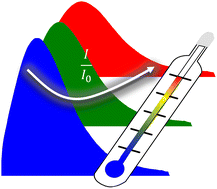Unexpected luminescence of non-conjugated biomass-based polymers: new approach in photothermal imaging†
Abstract
Population growth, depletion of world resources and persistent toxic chemical production underline the need to seek new smart materials from inexpensive, biodegradable, and renewable feedstocks. Hence, “metal-free” ring-opening copolymerization to convert biomass carvone-based monomers into non-conventional luminescent biopolymers is considered a sustainable approach to achieve these goals. The non-conventional emission was studied in terms of steady-state and time-resolved spectroscopy in order to unravel the structure-properties for different carvone-based copolymers. The results highlighted the importance of the final copolymer folding structure as well as its environment in luminescent behavior (cluster-triggered emission). In all cases, their luminescent behavior is sensitive to small temperature fluctuations (where the minimum detected temperature is Tm ∼ 2 °C and relative sensitivity is Sr ∼ 6% °C) even at the microscopic scale, which endows these materials a great potential as thermosensitive smart polymers for photothermal imaging.



 Please wait while we load your content...
Please wait while we load your content...